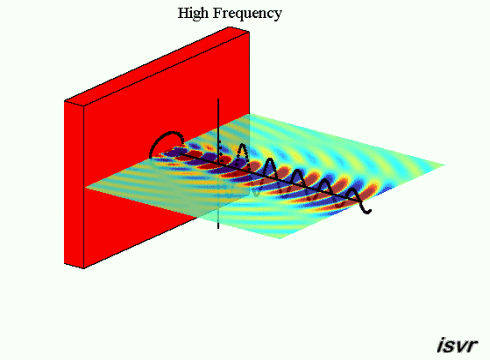Radiation from a loudspeaker
A loudspeaker can be modelled as a piston-type source. This is a flat solid disk set in an infinite plane baffle that moves to and fro along its axis of symmetry. It is possible to calculate exactly the sound pressure fluctuations produced at locations well away from the piston (the acoustic far-field).
From the animations below, it can be seen that the radiation pattern of a loudspeaker is different at low, medium and high frequencies.
At low frequencies, the sound field radiated by a loudspeaker spreads out evenly in all directions. For this animation, the acoustic wavelength λ is about four times larger than the disk radius R.

At higher frequencies, when λ = 1.5R, the sound pressure produced by a loudspeaker is mostly contained within a cone around the piston axis. So, at these frequencies, you will hear louder sound levels in front of the speaker. If you move to either side it will get quieter.

At even higher frequencies, when λ = 0.7R, the sound field radiated by a loudspeaker is constricted within a narrower cone around the piston axis. Now, the sound pressure levels fall off very rapidly as a listener steps away from in front of the loudspeaker. You can test this by listening to your hi-fi loudspeakers from the side or the back. The sound will be ‘muddier’ there because the high frequencies will only reach you by reflection from the walls or objects in the room.
